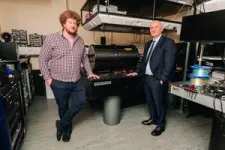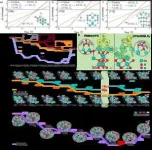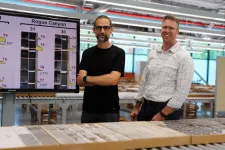(Press-News.org) Work has started on a new Quantum Communications Hub Optical Ground Station (HOGS), a state-of-the-art telescope which is being built on Heriot-Watt University’s Research Park.
The new facility will demonstrate and test satellite quantum secure communications, maintaining and growing the UK’s strength in the field of quantum technologies. It is scheduled to be fully operational by late Autumn [2024].
As well as helping to tackle future cyberattacks by researching methods to send secure transmissions via satellites, it will unlock new research on space environmentalism alongside innovative R&D activities for future laser communication networks. These provide high bandwidth communications services like 6G and beyond.
The facility will feature a plethora of cameras, sensors, and other photonic technologies enabling HOGS to expand how it can be used for both UK-based and international researchers and industry contacts. HOGS will also be directly connected to a new University campus optical fibre network, being developed alongside HOGS, allowing innovative teams to demonstrate deployment of optical, quantum, and hybrid communication networks.
The new capabilities will support space environmentalism by finding debris, accurately tracking satellites and developing new techniques to find objects that haven't been seen before and improving the identification of what the object is. The telescope may also open opportunities for teams to explore new de-orbiting techniques for small space-debris using lasers.
The facility is being built as part of the Quantum Communications Hub project, funded through the UK National Quantum Technologies Programme and is part of a collaborative effort which also involves the Universities of Bristol, Strathclyde, and York. Space engineering expertise is provided by the Science and Technology Facilities Council’s RAL Space Facility.
Other UK researchers with relevant interests in experimental satellite quantum communications will be invited to work onsite using the modern telescope to track satellite paths with high precision. Heriot-Watt students, from undergraduate to PhD, will benefit from the new capabilities while local school children will be hosted onsite to build their knowledge and understanding of satellite communications and astronomy.
Dr Ross Donaldson from Heriot-Watt University is leading the project. He said: “We want to show that UK scientists have the capabilities to deliver satellite quantum-based communications and have the expertise to do all the required operations. Creating secure global connectivity is the goal and we look forward to demonstrating our abilities once the Optical Ground Station is up and running.
“This new facility will provide UK and international teams with the opportunity to trial new techniques and technologies for innovative R&D as well as space environmentalism. Our high latitude location offers us the chance to track space junk and debris in polar orbits for long periods of time, which may allow us to identify smaller objects.”
Professor Tim Spiller, director of the Quantum Communications Hub, said: “Satellites will form an essential part of future worldwide quantum communications, and in-orbit demonstrator missions are essential in proving the UK’s capabilities as a leader in secure quantum communications. The ground-based receiver is clearly a key element of any mission, and we look forward to the Hub Optical Ground Station becoming operational at Heriot-Watt University.”
Heriot-Watt University has world leading expertise in quantum communications and associated technologies behind it. The new HOGS facility represents a major step towards creating a ‘space cluster’ on the institution’s Edinburgh campus.
Professor Gill Murray, deputy principal of business and enterprise at Heriot-Watt University welcomed the work beginning on site. She said: “Heriot-Watt University is at the forefront of creating and supporting new growth sectors through our research, innovation and pipeline of talented students. Our new Optical Ground Station will create a dynamic new environment where innovation is encouraged. We have seen an explosion in growth within the space technology sector and higher education has a key role to play to capitalise on this growth.
“By actively engaging with businesses that operate in the space sector, we can push the boundaries of what is possible. Our researchers and students bring fresh perspectives, diverse skill sets, and a passion for discovery. Through forging partnerships with industry partners, business leaders and government, we can fully maximise resources like the new Optical Ground Station to channel academic energy into practical solutions, driving advancements that benefit both higher education and broader society.”
Graham McPhail, head of property strategy at Heriot-Watt University, said: “Having the Optical Ground Station on the university’s campus further elevates Heriot-Watt’s space and quantum potential beyond those offered by other research parks. As the largest and most prominent of Scotland’s science-based parks, with more than 1,000 staff working across 28 organisations, companies occupying Heriot-Watt Research Park can make full use of the amenities available on the campus in a location that offers unrivalled access to Scotland’s capital city and the central belt. Every day the campus is filled with our talented students, researchers and existing industry partners including Celestia UK, renowned for its expertise in antenna systems for satellite tracking.
“We are also supporting the university’s wider sustainability goals, ensuring we use existing campus infrastructure and minimise transport costs wherever possible. Operating from the campus means students that are studying our new Aerospace Engineering degree and aligned qualifications can benefit from access, helping the University to produce workplace-ready graduates who are able to meet the requirements of this emerging sector.”
Last month, Heriot-Watt announced it will lead a groundbreaking new quantum research hub that aims to develop technologies to progress an ultra-secure quantum internet of the future. The Integrated Quantum Networks (IQN) Hub is one of five new quantum technology hubs announced by the UK government as part of a £160 million investment to ensure the UK remains at the forefront of these revolutionary technologies. The IQN Hub will build on the work of the current Quantum Communications Hub, including space, to create new use cases for HOGS in the future.
Anyone wishing to learn more about Heriot-Watt’s strategy for Scotland’s next Space Tech Cluster or about opportunities to collaborate with the Optical Ground Station should contact mediaenquiries@hw.ac.uk.
ENDS
For more information, please contact: Annie Pugh, 07939 153 649, a.pugh@hw.ac.uk
Images:
Breaking ground shots and lab shots can be found here https://www.dropbox.com/scl/fo/47o4uxbhmruk24g3v5whm/AJAf51n5dC1cpvBPkjUiZa0/high%20Res?dl=0&rlkey=ss2lkpodjedwp3eq6nkkk5djg&subfolder_nav_tracking=1
About Heriot-Watt University
Heriot-Watt University is a global research-led university based in the UK, with five campuses in Edinburgh, the Scottish Borders, Orkney, Dubai and Malaysia.
Around 27,000 students from 154 countries are currently studying with us. We have 159,000 alumni in 190 countries.
We are specialists in business, engineering, design and the physical, social, sports, environmental and life sciences subjects which make a real impact on the world and society.
Heriot-Watt was founded in Edinburgh in 1821 as the world’s first mechanics institute. In 1966, it became a university by Royal Charter. The university is named after 18th century Scottish engineer and inventor James Watt and 16th century Scottish philanthropist and goldsmith George Heriot.
86.8% of Heriot-Watt's research is classed as world-leading and internationally excellent in the Research Excellence Framework 2021 – the UK’s system for assessing the excellence of research in UK higher education providers.
The university runs 113 undergraduate programmes and 170 postgraduate programmes across six academic schools and Edinburgh Business School.
Our six academic schools are:
Energy, Geoscience, Infrastructure and Society
Engineering and Physical Sciences
Mathematical and Computer Sciences
Social Sciences
Textiles and Design
Global College
Edinburgh Business School is one of the world's largest providers of postgraduate business education, with 49,000 alumni across 158 countries.
Website: https://www.hw.ac.uk/
END
Heriot-Watt University breaks ground on new £2.5M Optical Ground Station
Facility enables space innovation, space environmentalism and cybersecurity
2024-08-28
ELSE PRESS RELEASES FROM THIS DATE:
SUNY Board of Trustees and Chancellor King announce presidential appointment at SUNY College of Optometry
2024-08-28
New York, NY – The State University of New York Board of Trustees today appointed Dr. David Troilo as president of SUNY College of Optometry. He is the 4th president to serve the state’s only college of optometry, following the retirement of Dr. David A. Heath after 17 years of dedicated service to the campus. Dr. Troilo’s appointment is effective immediately.
The SUNY Board of Trustees said, “SUNY College of Optometry is a center of research and academic excellence, and Dr. Troilo is a collaborative and thoughtful leader who is ready to move the campus forward growing ...
Cold math, hot topic: Sea ice thermal conductivity
2024-08-28
A new applied mathematical theory could enhance our understanding of how sea ice affects global climate, potentially improving the accuracy of climate predictions.
The authors of a new paper published in the Proceedings of the Royal Society A on 28 August, offer new insights into how heat travels through sea ice, a crucial factor in regulating Earth's polar climate.
Dr Noa Kraitzman, Senior Lecturer in Applied Mathematics at Macquarie University and lead author of the study, says the research addresses a key gap in current climate modelling.
“Sea ice covers about 15 per cent of the ocean’s surface during ...
Individuals with type 2 diabetes who are at higher risk of certain cancers could be identified by a simple blood test, Danish study suggests
2024-08-28
Individuals with type 2 diabetes who are at higher risk of certain cancers could be identified by a simple blood test, this year’s Annual Meeting of the European Association for the Study of Diabetes (EASD) (Madrid, 9-13 September) will hear.
People with type 2 diabetes are known to be at higher risk of developing cancers associated with obesity (OR cancers), including breast, kidney, womb, thyroid and ovarian cancer, as well as gastrointestinal cancers, including colorectal and pancreatic ...
New UT School of Public Health San Antonio welcomes inaugural class, launches degree program designed for South Texas
2024-08-27
The University of Texas School of Public Health San Antonio (UT School of Public Health San Antonio), a collaboration between The University of Texas Health Science Center at San Antonio (UT Health San Antonio) and The University of Texas at San Antonio (UTSA), proudly welcomes its inaugural class and the official launch of the region’s first Master of Public Health (MPH) graduate degree program.
Beginning Monday, Aug. 26, the first cohort of 40 students will attended classes at the new UT School of Public Health San Antonio, located on the Greehey Campus at UT Health San Antonio. Many of the students in the program ...
Mizzou researchers explore solutions to help reduce nurse burnout
2024-08-27
COLUMBIA, Mo. -- Even before the coronavirus pandemic, high rates of burnout and staffing shortages plagued the nursing industry, primarily because of the stressful demands of the job. The COVID-19 pandemic only amplified these challenges, and with nearly a third of all Missouri nurses nearing retirement, improving nurse retention is key to avoiding an impending nursing workforce crisis in our state.
Despite dozens of studies proving burnout is an issue, few provide interventions to help nurses — and their patients — overcome its challenges.
A recent study by the University of Missouri has found that ...
Algorithm raises new questions about Cascadia earthquake record
2024-08-27
The Cascadia subduction zone in the Pacific Northwest has a history of producing powerful and destructive earthquakes that have sunk forests and spawned tsunamis that reached all the way to the shores of Japan.
The most recent great earthquake was in 1700. But it probably won’t be the last. And the area that stands to be affected is now bustling metropolises that are home to millions of people.
Figuring out the frequency of earthquakes – and when the next “big one” will happen – is an active scientific question that involves looking for signs of past earthquakes in the geologic record in the form of shaken up rocks, ...
Defining chronic pain for high-performance athletes with disabilities
2024-08-27
With the Paris 2024 Paralympic Games just around the corner, the extensive training and the sacrifices athletes make to compete at the games take centre stage.
For Paralympians and high-performance athletes with spinal cord injuries (SCI), assessing chronic pain plays a key role in their training and readiness to compete. However, the source of chronic pain is often misattributed to acute trauma or overuse injuries. While the International Olympic Committee acknowledges pain management data among Paralympians and athletes with disabilities is limited, few studies have been launched investigating this dilemma.
Now, new research from UBC Okanagan highlights the need for more comprehensive ...
Illinois researchers develop near-infrared spectroscopy models to analyze corn kernels, biomass
2024-08-27
URBANA, Ill. – In the agricultural and food industry, determining the chemical composition of raw materials is important for production efficiency, application, and price. Traditional laboratory testing is time-consuming, complicated, and expensive. New research from the University of Illinois Urbana-Champaign demonstrates that near-infrared (NIR) spectroscopy and machine learning can provide quick, accurate, and cost-effective product analysis.
In two studies, the researchers explore the use of NIR spectroscopy for analyzing characteristics of corn kernels and sorghum biomass.
“NIR spectroscopy has many advantages over traditional methods. ...
It’s the most common STI you’ve never heard of. Will this newly developed drug provide the cure?
2024-08-27
Researchers at Tulane University are leading a groundbreaking study to seek a more effective treatment for trichomoniasis, an infection that, despite being the most common curable sexually transmitted infection (STI) worldwide, continues to fly under the radar.
The five-year, multi-center study is funded by a $9.2 million National Institutes of Health grant and will compare the effectiveness of a recently approved medication, secnidazole, against the current standard treatment, metronidazole, using ...
Texas A&M researchers find that aoudad, bighorn sheep share respiratory pathogens
2024-08-27
By Courtney Price, Texas A&M College of Veterinary Medicine and Biomedical Sciences
A team of researchers at the Texas A&M College of Veterinary Medicine and Biomedical Sciences (VMBS) has discovered that aoudad — an animal in the sheep and goat family — can catch and spread many of the same respiratory pathogens that can impact desert bighorn sheep, a native species in Texas that often shares its habitat with aoudad.
The new research, recently published in the journal PLOS ONE, will help wildlife conservationists better understand the complex relationship between ...
LAST 30 PRESS RELEASES:
American College of Cardiology comments on new dietary guidelines for Americans
American Society of Gene & Cell Therapy and Orphan Therapeutics Accelerator partner to advance and commercialize promising rare disease treatments
One in 14 patients having day case surgery have new or worse chronic pain 3 months after their operation
New study highlights link between eviction rates and gun violence
Heatwaves heat up soil but not toxin levels in rice, study finds
Digital modeling reveals where construction carbon emissions really come from
Turning farm waste into water filters
New study shows how the spleen helps the immune system accept a transplant
New Mayo Clinic study advances personalized prostate cancer education with an EHR-integrated AI agent
Researchers identify novel therapeutic target to improve recovery after nerve injury
Microbes in breast milk help populate infant gut microbiomes
Reprogramming immunity to rewrite the story of Type 1 diabetes
New tool narrows the search for ideal material structures
Artificial saliva containing sugarcane protein helps protect the teeth of patients with head and neck cancer
Understanding the role of linear ubiquitination in T-tubule biogenesis
Researchers identify urban atmosphere as primary reservoir of microplastics
World’s oldest arrow poison – 60,000-year-old traces reveal early advanced hunting techniques
Bristol scientists discover early sponges were soft
New study uncovers how rice viruses manipulate plant defenses to protect insect vectors
NSF–DOE Vera C. Rubin Observatory spots record-breaking asteroid in pre-survey observations
Ribosomal engineering creates “super-probiotic” bacteria
This self-powered eye tracker harnesses energy from blinking and is as comfortable as everyday glasses
Adverse prenatal exposures linked to higher rates of mental health issues, brain changes in adolescents
Restoring mitochondria shows promise for treating chronic nerve pain
Nature study identifies a molecular switch that controls transitions between single-celled and multicellular forms
USU chemists' CRISPR discovery could lead to single diagnostic test for COVID, flu, RSV
Early hominins from Morocco reveal an African lineage near the root of Homo sapiens
Small chimps, big risks: What chimps show us about our own behavior
We finally know how the most common types of planets are created
Thirty-year risk of cardiovascular disease among healthy women according to clinical thresholds of lipoprotein(a)
[Press-News.org] Heriot-Watt University breaks ground on new £2.5M Optical Ground StationFacility enables space innovation, space environmentalism and cybersecurity







